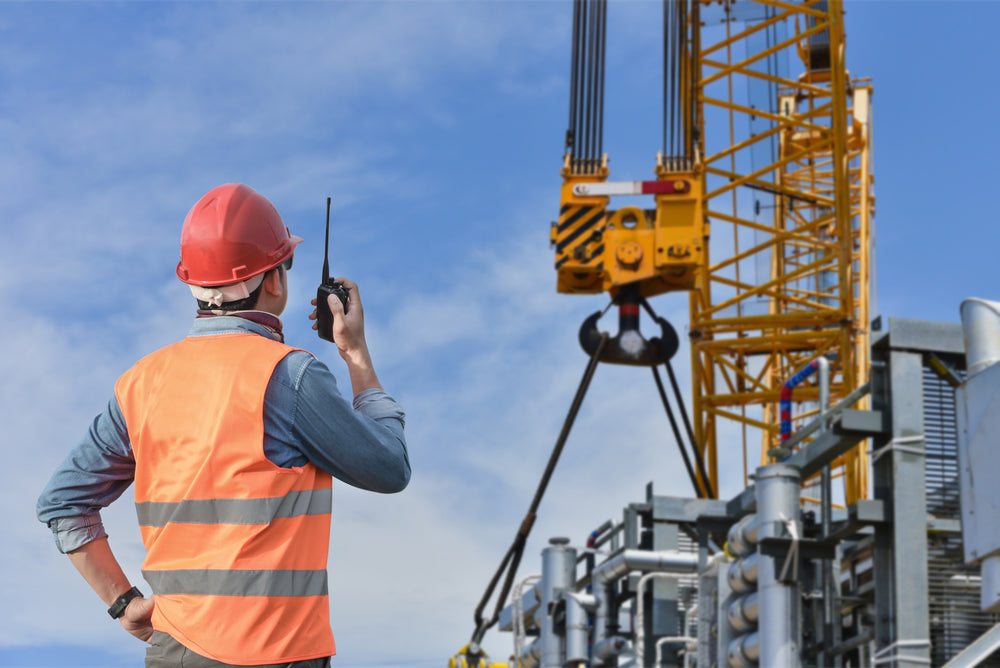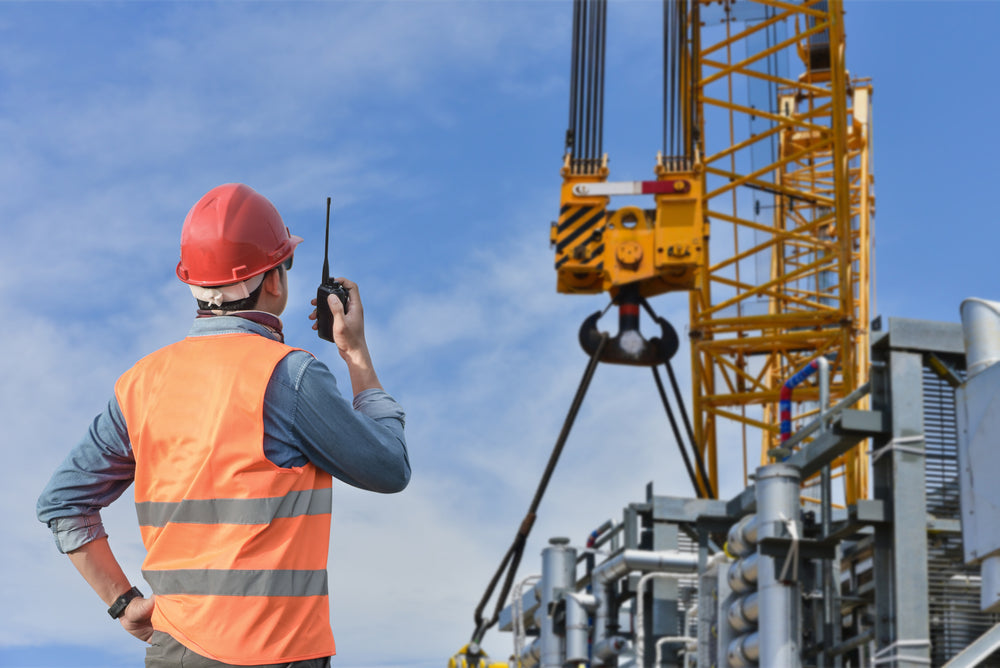TLILIC0023 License to Operate a Slewing Mobile Crane (up to 60 tonnes) Training Course - Salisbury, Brisbane

TLILIC0023 License to Operate a Slewing Mobile Crane (up to 60 tonnes) Training Course - Salisbury, Brisbane
Out of stock
Welcome to TLILIC0023 License to Operate a slewing mobile crane (up to 60 tonnes) training course. The successful completion of this course will allow you to apply for a C6 high risk work licence.
This Queensland-based training course specifies the skills and knowledge required to safely operate a slewing mobile crane with a Maximum Rated Capacity (MRC) up to 60 tonnes in accordance with all relevant legislative responsibilities.
Competence in this unit, does not in itself result in a High-Risk Work Licence (HRWL) to operate this plant.
Slewing mobile crane means a mobile crane incorporating a boom or jib that can be slewed, but does not include:
-
A front-end loader, or
-
A backhoe, or
-
An excavator, or
-
Other earth moving equipment, when configured for crane operation.
A person performing this work is required to hold a slewing mobile crane with an MRC up to 60 tonnes HRWL.
This unit requires a person operating a slewing mobile crane with an MRC up to 60 tonnes to:
-
Plan for the work/task.
-
Prepare for the work/task.
-
Perform work/task.
-
Pack up.
Legislative and regulatory requirements are applicable to this unit of competency.
This unit is based on the licensing requirements of Part 4.5 of the Model Work Health and Safety (WHS) regulations and meets Commonwealth, state and territory HRWL requirements.
The National Assessment Instrument (NAI) is the mandated assessment for the HRWL to operate the relevant licensing class as detailed in this unit.
The OHS.com.au & Kallibr Training Advantage
- Quality training – our sites replicate real-world construction sites and our clients find that highly valuable.
- Convenience - we run an extensive public course schedule and can also do private courses at your worksite.
- Experience - our trainers are from industry and have typically have decades of practical experience which is critical for high risk work environments
Where will the course be held in Queensland?
Training Provider: Kallibr Training (RTO 32365)
Location: Onsite training (Face to face)
Course length: 35 hours (Approx. 5 Days (4 days training plus 1 day assessment)
Certification / Accreditation: Nationally Recognised Statement of Attainment
Prerequisite: Nil but you will also need a white card to enter a work site
Kallibr Training is operating from Brisbane's largest construction training centre.
It is a licenced, insured and accredited RTO (32365). All the instructors have completed their Certificate IV in Training and Assessment and are highly experienced, vocational trainers.
This fully equipped facility is designed to provide the highest quality training. The training facility is located in Salisbury, offering a large array of equipment, structures and plant for construction, high-risk training, and access.
The Construction Training Centre is located at 460/492 Beaudesert Rd, Salisbury QLD 4107, Australia
Nearest train stations in Brisbane are: Salisbury (Train station), Moorooka (Transit station) and Coopers Plain (Train station).
Directions to 460-492 Beaudesert Road (Salisbury) with public transport.
The following Queensland transport lines have routes that pass near 460-492 Beaudesert Road.
- BusBus: 110,125.
- Train:FERN.
Background - How Can Regular Maintenance Prolong The Lifespan Of Your Slewing Mobile Crane?
Overlooking regular maintenance of your slewing mobile crane can lead to costly repairs and shorten its lifespan.
By implementing a structured maintenance schedule, you can ensure that your crane operates efficiently and safely for years to come.
For a proper understanding of your slewing mobile crane, it is important to familiarise yourself with its key components.
These include the boom, counterweights, slewing ring, hydraulic system, and control system.
Each component plays a crucial role in the overall functionality and safety of the crane.
The boom is responsible for lifting and lowering heavy loads, while the counterweights provide stability.
The slewing ring allows the crane to rotate 360 degrees, and the hydraulic system powers the crane's movements.
Lastly, the control system enables operators to maneuver the crane with precision and safety.
Proper maintenance of each component of your slewing mobile crane can significantly impact its lifespan and performance.
Regular inspections, lubrication, and repairs can help prevent wear and tear, ensuring that the crane operates smoothly and efficiently for years to come.
Monthly Maintenance Tasks:
-
Thorough inspection of structural components for signs of damage or fatigue.
-
Lubrication of moving parts such as bearings, gears, and joints to prevent friction and wear.
-
Testing and calibration of safety features such as limit switches, overload protection systems, and emergency stop mechanisms.
-
Checking and tightening bolts, nuts, and fasteners to ensure structural integrity.
-
Examination of electrical systems including wiring, connections, and controls for any issues or abnormalities.
Annual Maintenance Tasks:
-
Comprehensive examination of the entire crane structure, including the boom, jib, and mast, for any cracks, corrosion, or deformation.
-
Inspection of wire ropes, cables, and chains for wear, corrosion, or damage, and replacing if necessary.
-
Evaluation of hydraulic systems for leaks, proper fluid levels, and functionality.
-
Testing of load cells and other load-measuring devices for accuracy and reliability.
-
Review and update of maintenance records and documentation to track the crane's maintenance history and compliance with regulatory requirements.
Slewing mobile cranes’ license requirement in Queensland
You will need to apply for the relevant high risk work licence class in Queensland.
These licences are:
20 tonne capacity - C2 high risk work licence
The class of work is operator of a slewing mobile crane with a capacity of up to 20 tonnes.
This licence also includes authority for the operation of:
-
non-slewing mobile crane – CN.
-
vehicle loading crane - CV - (excluding the application of load estimation and slinging techniques).
-
reach stacker - RS.
60 tonne capacity - C6 high risk work licence
The class of work is operation of a slewing mobile crane with a capacity of up to 60 tonnes.
This licence also includes authority for the slewing mobile crane with a capacity of:
-
20 tonnes or less - C2.
-
non-slewing mobile crane – CN.
-
vehicle loading crane - CV - (excluding the application of load estimation and slinging techniques).
-
reach stacker - RS.
100 tonne capacity - C1 high risk work licence
The class of work is operation of a slewing mobile crane with a capacity of up to 100 tonnes.
This licence also includes authority for the operation of slewing mobile cranes with a capacity of:
-
60 tonnes or less - C6.
-
20 tonnes or less - C2.
-
non-slewing mobile crane – CN.
-
vehicle loading crane - CV - (excluding the application of load estimation and slinging techniques).
-
reach stacker - RS.
Capacity over 100 tonnes - C0 high risk work licence
The class of work is operator of a slewing mobile crane with a capacity exceeding 100 tonnes.
This licence also includes authority for the slewing mobile crane with a capacity of:
-
100 tonnes or less - C1.
-
60 tonnes or less - C6.
-
20 tonnes or less - C2.
-
non-slewing mobile crane – CN.
-
vehicle loading crane - CV - (excluding the application of load estimation and slinging techniques).
-
reach stacker - RS.
Operator competency and licensing
A person must hold a high risk work (HRW) licence to operate a vehicle loading crane that has a capacity of 10 metre tonnes or more.
This can be a:
Vehicle Loading Crane HRW Licence or one of the four slewing mobile crane HRW licences (Slewing Mobile Crane - with a capacity up to 20 tonnes; Slewing Mobile Crane - capacity up to 60 tonnes; Slewing Mobile Crane - capacity up to 100 tonnes and Slewing Mobile Crane - capacity over 100 tonnes).
A crane has a capacity of 10 metre tonnes if at any position on the crane's load chart, the radius (in metres) multiplied by the load (in tonnes) is equal to or greater than 10.
A person with a vehicle loading crane HRW licence is able to apply load estimation and slinging techniques when operating the VLC under regular circumstances.
A licensed dogger is required in the Queensland if:
-
The VLC is being used to position loads in elevated or remote positions.
-
The operator is operating the crane under a slewing mobile crane licence.
What will you learn?
-
Task requirements are identified from work orders or equivalent, a lift plan is confirmed with associated personnel and a site inspection is conducted in accordance with workplace procedures.
-
Mobile crane Rated Capacity (RC) and the lifting gear Working Load Limit (WLL) are established and suitable for the load/s and work/task requirements in accordance with manufacturer requirements and workplace procedures.
-
Traffic management plan implementation is confirmed in accordance with workplace procedures.
-
Appropriate communication procedures are identified with associated personnel in accordance with workplace procedures.
-
Risk control measures for hazards identified are checked for implementation in accordance with the lift plan and safe work procedures.
-
Mobile crane is accessed safely in accordance with manufacturer requirements and safe work procedures.
-
Counterweight/s are set up as required in accordance with the lift plan, relevant manufacturer requirements and safe work procedures.
-
Fly jib and/or luffing fly are set up as required in accordance with specific manufacturer requirements and safe work procedures.
-
Operational checks are carried out and any damage and defects are reported, recorded and appropriate action is taken in accordance with manufacturer requirements and safe work procedures.
-
Crane logbook is checked to confirm current compliance, is correct for the crane type, is completed and signed and required rectifications have been signed off in accordance with manufacturer requirements and safe work procedures.
-
Boom/jib and hook block are safely positioned over the load following directions from associated personnel in accordance with the lift plan and safe work procedures.
-
Main and/or auxiliary hook, including any lifting gear where required, are connected to the load and used safely in accordance with the lift plan, safe work procedures and manufacturer requirements.
-
Crane boom/jib, lifting gear and associated equipment are stowed and secured as required in accordance with manufacturer requirements and safe work procedures.
-
Crane fly jib and/or luffing fly and counterweight/s are removed to storage position and secured as required in accordance with manufacturer requirements and safe work procedures.
-
Relevant motion locks and brakes are applied as required in accordance with manufacturer requirements and safe work procedures.
-
Outriggers, plates and/or packing are stowed and secured in accordance with manufacturer requirements and safe work procedures.
Upon successful completion of this course, student will be awarded a Statement of Attainment and therefore the ability to apply for a High-Risk Work Licence to Operate a Vehicle Loading Crane by WorkSafe Queensland.
Course Outcomes
- Statement of Attainment Nationally Recognised
- Ability to apply for a C6 high risk work licence
- Credit towards a full qualification.
- Continue your education and improve your career prospects with these strong pathways.
Entry requirements
- Reached 18 years of age to sit the SafeWork Queensland assessment.
- A general construction induction card (commonly known as a white card).
- Proof of Queensland residential address
- 100 points for identification for the SafeWork assessment.
-
Students will need to have a basic understanding and knowledge of English.
The application form for a new Queensland HRW Licence must be completed online on the Worksafe QLD site.
The application must be submitted within 60 days after the successful completion of the practical assessment.
A Candidate Assessment Summary (CAS) is a document that shows the results of an assessment or part of an assessment. Students should keep their CAS as well as the proof of payment for the application for the licence to legally prove they can lawfully perform the work until they receive their HRW licence.
Workplace Health and Safety QLD can be contacted on 1300 369 911 for any questions regarding your application.
SKU:
Course Highlights:
- 5 days Face-to-Face
- Expert-Led + Practical
- Quality Focused
- Fast Certification
- Tax Deductable
- Trusted RTO Provider
- Statement of Attainment
- Nationally Recognised
Couldn't load pickup availability

"Well run course! The trainer was very efficient, well prepared, communicated clearly what we would cover and finished on time 👍"
Nathan"Good customer service great knowledge and understanding from the trainers couldn’t recommend a better place to be trained"
Melanie"The course was very informative. Going into the course I didn’t think I’d learn anything new but I was astonished with how much I learnt."
Paul.P"This course was Informative and practical shout out to John for leading the session."
JayADDITIONAL EXTRA BONUSES with OHS.com.au
Claim up to $1271.95 worth of Extra Bonuses
with every purchase
- Your personal copy of Safety Legends E-Book (value $39.95)
- $100 off your first case from Naked Wines (value $100)
- Upto 350,000 Bonus AMEX Frequent Flyer points* (value $1000)
- Complimentary Access to two online courses** (value $132)
$1271.95 EXTRA VALUE - JUST FOR YOU INSIDE!
* New customers when you successfully sign up for a new personal / business credit card ** Indigenous Cultural Awareness / Impacts of Climate Change coursesDescription
Welcome to TLILIC0023 License to Operate a slewing mobile crane (up to 60 tonnes) training course. The successful completion of this course will allow you to apply for a C6 high risk work licence.
This Queensland-based training course specifies the skills and knowledge required to safely operate a slewing mobile crane with a Maximum Rated Capacity (MRC) up to 60 tonnes in accordance with all relevant legislative responsibilities.
Competence in this unit, does not in itself result in a High-Risk Work Licence (HRWL) to operate this plant.
Slewing mobile crane means a mobile crane incorporating a boom or jib that can be slewed, but does not include:
-
A front-end loader, or
-
A backhoe, or
-
An excavator, or
-
Other earth moving equipment, when configured for crane operation.
A person performing this work is required to hold a slewing mobile crane with an MRC up to 60 tonnes HRWL.
This unit requires a person operating a slewing mobile crane with an MRC up to 60 tonnes to:
-
Plan for the work/task.
-
Prepare for the work/task.
-
Perform work/task.
-
Pack up.
Legislative and regulatory requirements are applicable to this unit of competency.
This unit is based on the licensing requirements of Part 4.5 of the Model Work Health and Safety (WHS) regulations and meets Commonwealth, state and territory HRWL requirements.
The National Assessment Instrument (NAI) is the mandated assessment for the HRWL to operate the relevant licensing class as detailed in this unit.
The OHS.com.au & Kallibr Training Advantage
- Quality training – our sites replicate real-world construction sites and our clients find that highly valuable.
- Convenience - we run an extensive public course schedule and can also do private courses at your worksite.
- Experience - our trainers are from industry and have typically have decades of practical experience which is critical for high risk work environments
Where will the course be held in Queensland?
Training Provider: Kallibr Training (RTO 32365)
Location: Onsite training (Face to face)
Course length: 35 hours (Approx. 5 Days (4 days training plus 1 day assessment)
Certification / Accreditation: Nationally Recognised Statement of Attainment
Prerequisite: Nil but you will also need a white card to enter a work site
Kallibr Training is operating from Brisbane's largest construction training centre.
It is a licenced, insured and accredited RTO (32365). All the instructors have completed their Certificate IV in Training and Assessment and are highly experienced, vocational trainers.
This fully equipped facility is designed to provide the highest quality training. The training facility is located in Salisbury, offering a large array of equipment, structures and plant for construction, high-risk training, and access.
The Construction Training Centre is located at 460/492 Beaudesert Rd, Salisbury QLD 4107, Australia
Nearest train stations in Brisbane are: Salisbury (Train station), Moorooka (Transit station) and Coopers Plain (Train station).
Directions to 460-492 Beaudesert Road (Salisbury) with public transport.
The following Queensland transport lines have routes that pass near 460-492 Beaudesert Road.
- BusBus: 110,125.
- Train:FERN.
Background - How Can Regular Maintenance Prolong The Lifespan Of Your Slewing Mobile Crane?
Overlooking regular maintenance of your slewing mobile crane can lead to costly repairs and shorten its lifespan.
By implementing a structured maintenance schedule, you can ensure that your crane operates efficiently and safely for years to come.
For a proper understanding of your slewing mobile crane, it is important to familiarise yourself with its key components.
These include the boom, counterweights, slewing ring, hydraulic system, and control system.
Each component plays a crucial role in the overall functionality and safety of the crane.
The boom is responsible for lifting and lowering heavy loads, while the counterweights provide stability.
The slewing ring allows the crane to rotate 360 degrees, and the hydraulic system powers the crane's movements.
Lastly, the control system enables operators to maneuver the crane with precision and safety.
Proper maintenance of each component of your slewing mobile crane can significantly impact its lifespan and performance.
Regular inspections, lubrication, and repairs can help prevent wear and tear, ensuring that the crane operates smoothly and efficiently for years to come.
Monthly Maintenance Tasks:
-
Thorough inspection of structural components for signs of damage or fatigue.
-
Lubrication of moving parts such as bearings, gears, and joints to prevent friction and wear.
-
Testing and calibration of safety features such as limit switches, overload protection systems, and emergency stop mechanisms.
-
Checking and tightening bolts, nuts, and fasteners to ensure structural integrity.
-
Examination of electrical systems including wiring, connections, and controls for any issues or abnormalities.
Annual Maintenance Tasks:
-
Comprehensive examination of the entire crane structure, including the boom, jib, and mast, for any cracks, corrosion, or deformation.
-
Inspection of wire ropes, cables, and chains for wear, corrosion, or damage, and replacing if necessary.
-
Evaluation of hydraulic systems for leaks, proper fluid levels, and functionality.
-
Testing of load cells and other load-measuring devices for accuracy and reliability.
-
Review and update of maintenance records and documentation to track the crane's maintenance history and compliance with regulatory requirements.
Slewing mobile cranes’ license requirement in Queensland
You will need to apply for the relevant high risk work licence class in Queensland.
These licences are:
20 tonne capacity - C2 high risk work licence
The class of work is operator of a slewing mobile crane with a capacity of up to 20 tonnes.
This licence also includes authority for the operation of:
-
non-slewing mobile crane – CN.
-
vehicle loading crane - CV - (excluding the application of load estimation and slinging techniques).
-
reach stacker - RS.
60 tonne capacity - C6 high risk work licence
The class of work is operation of a slewing mobile crane with a capacity of up to 60 tonnes.
This licence also includes authority for the slewing mobile crane with a capacity of:
-
20 tonnes or less - C2.
-
non-slewing mobile crane – CN.
-
vehicle loading crane - CV - (excluding the application of load estimation and slinging techniques).
-
reach stacker - RS.
100 tonne capacity - C1 high risk work licence
The class of work is operation of a slewing mobile crane with a capacity of up to 100 tonnes.
This licence also includes authority for the operation of slewing mobile cranes with a capacity of:
-
60 tonnes or less - C6.
-
20 tonnes or less - C2.
-
non-slewing mobile crane – CN.
-
vehicle loading crane - CV - (excluding the application of load estimation and slinging techniques).
-
reach stacker - RS.
Capacity over 100 tonnes - C0 high risk work licence
The class of work is operator of a slewing mobile crane with a capacity exceeding 100 tonnes.
This licence also includes authority for the slewing mobile crane with a capacity of:
-
100 tonnes or less - C1.
-
60 tonnes or less - C6.
-
20 tonnes or less - C2.
-
non-slewing mobile crane – CN.
-
vehicle loading crane - CV - (excluding the application of load estimation and slinging techniques).
-
reach stacker - RS.
Operator competency and licensing
A person must hold a high risk work (HRW) licence to operate a vehicle loading crane that has a capacity of 10 metre tonnes or more.
This can be a:
Vehicle Loading Crane HRW Licence or one of the four slewing mobile crane HRW licences (Slewing Mobile Crane - with a capacity up to 20 tonnes; Slewing Mobile Crane - capacity up to 60 tonnes; Slewing Mobile Crane - capacity up to 100 tonnes and Slewing Mobile Crane - capacity over 100 tonnes).
A crane has a capacity of 10 metre tonnes if at any position on the crane's load chart, the radius (in metres) multiplied by the load (in tonnes) is equal to or greater than 10.
A person with a vehicle loading crane HRW licence is able to apply load estimation and slinging techniques when operating the VLC under regular circumstances.
A licensed dogger is required in the Queensland if:
-
The VLC is being used to position loads in elevated or remote positions.
-
The operator is operating the crane under a slewing mobile crane licence.
What will you learn?
-
Task requirements are identified from work orders or equivalent, a lift plan is confirmed with associated personnel and a site inspection is conducted in accordance with workplace procedures.
-
Mobile crane Rated Capacity (RC) and the lifting gear Working Load Limit (WLL) are established and suitable for the load/s and work/task requirements in accordance with manufacturer requirements and workplace procedures.
-
Traffic management plan implementation is confirmed in accordance with workplace procedures.
-
Appropriate communication procedures are identified with associated personnel in accordance with workplace procedures.
-
Risk control measures for hazards identified are checked for implementation in accordance with the lift plan and safe work procedures.
-
Mobile crane is accessed safely in accordance with manufacturer requirements and safe work procedures.
-
Counterweight/s are set up as required in accordance with the lift plan, relevant manufacturer requirements and safe work procedures.
-
Fly jib and/or luffing fly are set up as required in accordance with specific manufacturer requirements and safe work procedures.
-
Operational checks are carried out and any damage and defects are reported, recorded and appropriate action is taken in accordance with manufacturer requirements and safe work procedures.
-
Crane logbook is checked to confirm current compliance, is correct for the crane type, is completed and signed and required rectifications have been signed off in accordance with manufacturer requirements and safe work procedures.
-
Boom/jib and hook block are safely positioned over the load following directions from associated personnel in accordance with the lift plan and safe work procedures.
-
Main and/or auxiliary hook, including any lifting gear where required, are connected to the load and used safely in accordance with the lift plan, safe work procedures and manufacturer requirements.
-
Crane boom/jib, lifting gear and associated equipment are stowed and secured as required in accordance with manufacturer requirements and safe work procedures.
-
Crane fly jib and/or luffing fly and counterweight/s are removed to storage position and secured as required in accordance with manufacturer requirements and safe work procedures.
-
Relevant motion locks and brakes are applied as required in accordance with manufacturer requirements and safe work procedures.
-
Outriggers, plates and/or packing are stowed and secured in accordance with manufacturer requirements and safe work procedures.
Upon successful completion of this course, student will be awarded a Statement of Attainment and therefore the ability to apply for a High-Risk Work Licence to Operate a Vehicle Loading Crane by WorkSafe Queensland.
Course Outcomes
- Statement of Attainment Nationally Recognised
- Ability to apply for a C6 high risk work licence
- Credit towards a full qualification.
- Continue your education and improve your career prospects with these strong pathways.
Entry requirements
- Reached 18 years of age to sit the SafeWork Queensland assessment.
- A general construction induction card (commonly known as a white card).
- Proof of Queensland residential address
- 100 points for identification for the SafeWork assessment.
-
Students will need to have a basic understanding and knowledge of English.
The application form for a new Queensland HRW Licence must be completed online on the Worksafe QLD site.
The application must be submitted within 60 days after the successful completion of the practical assessment.
A Candidate Assessment Summary (CAS) is a document that shows the results of an assessment or part of an assessment. Students should keep their CAS as well as the proof of payment for the application for the licence to legally prove they can lawfully perform the work until they receive their HRW licence.
Workplace Health and Safety QLD can be contacted on 1300 369 911 for any questions regarding your application.
- Money Back Guarantee
- Save Time & Money
- Tax Deductible
- 1000's Trained Each Month
- Quality-Focused
- Peer Reviewed Courses
- Trusted Industry Partner
- Fast Certification
- 60 Day Guarantee
- *See refund policy


Got multiple people needing to do a course? We will get back to you within a day!
Student Reviews

Couldn't load pickup availability

Contact Us!
Contact form
ADDITIONAL EXTRA BONUSES with OHS.com.au
Claim up to $1271.95 worth of Extra Bonuses
with every purchase
- Your personal copy of Safety Legends E-Book (value $39.95)
- $100 off your first case from Naked Wines (value $100)
- Upto 350,000 Bonus AMEX Frequent Flyer points* (value $1000)
- Complimentary Access to two online courses** (value $132)
$1271.95 EXTRA VALUE - JUST FOR YOU INSIDE!
* New customers when you successfully sign up for a new personal / business credit card ** Indigenous Cultural Awareness / Impacts of Climate Change coursesDescription
Welcome to TLILIC0023 License to Operate a slewing mobile crane (up to 60 tonnes) training course. The successful completion of this course will allow you to apply for a C6 high risk work licence.
This Queensland-based training course specifies the skills and knowledge required to safely operate a slewing mobile crane with a Maximum Rated Capacity (MRC) up to 60 tonnes in accordance with all relevant legislative responsibilities.
Competence in this unit, does not in itself result in a High-Risk Work Licence (HRWL) to operate this plant.
Slewing mobile crane means a mobile crane incorporating a boom or jib that can be slewed, but does not include:
-
A front-end loader, or
-
A backhoe, or
-
An excavator, or
-
Other earth moving equipment, when configured for crane operation.
A person performing this work is required to hold a slewing mobile crane with an MRC up to 60 tonnes HRWL.
This unit requires a person operating a slewing mobile crane with an MRC up to 60 tonnes to:
-
Plan for the work/task.
-
Prepare for the work/task.
-
Perform work/task.
-
Pack up.
Legislative and regulatory requirements are applicable to this unit of competency.
This unit is based on the licensing requirements of Part 4.5 of the Model Work Health and Safety (WHS) regulations and meets Commonwealth, state and territory HRWL requirements.
The National Assessment Instrument (NAI) is the mandated assessment for the HRWL to operate the relevant licensing class as detailed in this unit.
The OHS.com.au & Kallibr Training Advantage
- Quality training – our sites replicate real-world construction sites and our clients find that highly valuable.
- Convenience - we run an extensive public course schedule and can also do private courses at your worksite.
- Experience - our trainers are from industry and have typically have decades of practical experience which is critical for high risk work environments
Where will the course be held in Queensland?
Training Provider: Kallibr Training (RTO 32365)
Location: Onsite training (Face to face)
Course length: 35 hours (Approx. 5 Days (4 days training plus 1 day assessment)
Certification / Accreditation: Nationally Recognised Statement of Attainment
Prerequisite: Nil but you will also need a white card to enter a work site
Kallibr Training is operating from Brisbane's largest construction training centre.
It is a licenced, insured and accredited RTO (32365). All the instructors have completed their Certificate IV in Training and Assessment and are highly experienced, vocational trainers.
This fully equipped facility is designed to provide the highest quality training. The training facility is located in Salisbury, offering a large array of equipment, structures and plant for construction, high-risk training, and access.
The Construction Training Centre is located at 460/492 Beaudesert Rd, Salisbury QLD 4107, Australia
Nearest train stations in Brisbane are: Salisbury (Train station), Moorooka (Transit station) and Coopers Plain (Train station).
Directions to 460-492 Beaudesert Road (Salisbury) with public transport.
The following Queensland transport lines have routes that pass near 460-492 Beaudesert Road.
- BusBus: 110,125.
- Train:FERN.
Background - How Can Regular Maintenance Prolong The Lifespan Of Your Slewing Mobile Crane?
Overlooking regular maintenance of your slewing mobile crane can lead to costly repairs and shorten its lifespan.
By implementing a structured maintenance schedule, you can ensure that your crane operates efficiently and safely for years to come.
For a proper understanding of your slewing mobile crane, it is important to familiarise yourself with its key components.
These include the boom, counterweights, slewing ring, hydraulic system, and control system.
Each component plays a crucial role in the overall functionality and safety of the crane.
The boom is responsible for lifting and lowering heavy loads, while the counterweights provide stability.
The slewing ring allows the crane to rotate 360 degrees, and the hydraulic system powers the crane's movements.
Lastly, the control system enables operators to maneuver the crane with precision and safety.
Proper maintenance of each component of your slewing mobile crane can significantly impact its lifespan and performance.
Regular inspections, lubrication, and repairs can help prevent wear and tear, ensuring that the crane operates smoothly and efficiently for years to come.
Monthly Maintenance Tasks:
-
Thorough inspection of structural components for signs of damage or fatigue.
-
Lubrication of moving parts such as bearings, gears, and joints to prevent friction and wear.
-
Testing and calibration of safety features such as limit switches, overload protection systems, and emergency stop mechanisms.
-
Checking and tightening bolts, nuts, and fasteners to ensure structural integrity.
-
Examination of electrical systems including wiring, connections, and controls for any issues or abnormalities.
Annual Maintenance Tasks:
-
Comprehensive examination of the entire crane structure, including the boom, jib, and mast, for any cracks, corrosion, or deformation.
-
Inspection of wire ropes, cables, and chains for wear, corrosion, or damage, and replacing if necessary.
-
Evaluation of hydraulic systems for leaks, proper fluid levels, and functionality.
-
Testing of load cells and other load-measuring devices for accuracy and reliability.
-
Review and update of maintenance records and documentation to track the crane's maintenance history and compliance with regulatory requirements.
Slewing mobile cranes’ license requirement in Queensland
You will need to apply for the relevant high risk work licence class in Queensland.
These licences are:
20 tonne capacity - C2 high risk work licence
The class of work is operator of a slewing mobile crane with a capacity of up to 20 tonnes.
This licence also includes authority for the operation of:
-
non-slewing mobile crane – CN.
-
vehicle loading crane - CV - (excluding the application of load estimation and slinging techniques).
-
reach stacker - RS.
60 tonne capacity - C6 high risk work licence
The class of work is operation of a slewing mobile crane with a capacity of up to 60 tonnes.
This licence also includes authority for the slewing mobile crane with a capacity of:
-
20 tonnes or less - C2.
-
non-slewing mobile crane – CN.
-
vehicle loading crane - CV - (excluding the application of load estimation and slinging techniques).
-
reach stacker - RS.
100 tonne capacity - C1 high risk work licence
The class of work is operation of a slewing mobile crane with a capacity of up to 100 tonnes.
This licence also includes authority for the operation of slewing mobile cranes with a capacity of:
-
60 tonnes or less - C6.
-
20 tonnes or less - C2.
-
non-slewing mobile crane – CN.
-
vehicle loading crane - CV - (excluding the application of load estimation and slinging techniques).
-
reach stacker - RS.
Capacity over 100 tonnes - C0 high risk work licence
The class of work is operator of a slewing mobile crane with a capacity exceeding 100 tonnes.
This licence also includes authority for the slewing mobile crane with a capacity of:
-
100 tonnes or less - C1.
-
60 tonnes or less - C6.
-
20 tonnes or less - C2.
-
non-slewing mobile crane – CN.
-
vehicle loading crane - CV - (excluding the application of load estimation and slinging techniques).
-
reach stacker - RS.
Operator competency and licensing
A person must hold a high risk work (HRW) licence to operate a vehicle loading crane that has a capacity of 10 metre tonnes or more.
This can be a:
Vehicle Loading Crane HRW Licence or one of the four slewing mobile crane HRW licences (Slewing Mobile Crane - with a capacity up to 20 tonnes; Slewing Mobile Crane - capacity up to 60 tonnes; Slewing Mobile Crane - capacity up to 100 tonnes and Slewing Mobile Crane - capacity over 100 tonnes).
A crane has a capacity of 10 metre tonnes if at any position on the crane's load chart, the radius (in metres) multiplied by the load (in tonnes) is equal to or greater than 10.
A person with a vehicle loading crane HRW licence is able to apply load estimation and slinging techniques when operating the VLC under regular circumstances.
A licensed dogger is required in the Queensland if:
-
The VLC is being used to position loads in elevated or remote positions.
-
The operator is operating the crane under a slewing mobile crane licence.
What will you learn?
-
Task requirements are identified from work orders or equivalent, a lift plan is confirmed with associated personnel and a site inspection is conducted in accordance with workplace procedures.
-
Mobile crane Rated Capacity (RC) and the lifting gear Working Load Limit (WLL) are established and suitable for the load/s and work/task requirements in accordance with manufacturer requirements and workplace procedures.
-
Traffic management plan implementation is confirmed in accordance with workplace procedures.
-
Appropriate communication procedures are identified with associated personnel in accordance with workplace procedures.
-
Risk control measures for hazards identified are checked for implementation in accordance with the lift plan and safe work procedures.
-
Mobile crane is accessed safely in accordance with manufacturer requirements and safe work procedures.
-
Counterweight/s are set up as required in accordance with the lift plan, relevant manufacturer requirements and safe work procedures.
-
Fly jib and/or luffing fly are set up as required in accordance with specific manufacturer requirements and safe work procedures.
-
Operational checks are carried out and any damage and defects are reported, recorded and appropriate action is taken in accordance with manufacturer requirements and safe work procedures.
-
Crane logbook is checked to confirm current compliance, is correct for the crane type, is completed and signed and required rectifications have been signed off in accordance with manufacturer requirements and safe work procedures.
-
Boom/jib and hook block are safely positioned over the load following directions from associated personnel in accordance with the lift plan and safe work procedures.
-
Main and/or auxiliary hook, including any lifting gear where required, are connected to the load and used safely in accordance with the lift plan, safe work procedures and manufacturer requirements.
-
Crane boom/jib, lifting gear and associated equipment are stowed and secured as required in accordance with manufacturer requirements and safe work procedures.
-
Crane fly jib and/or luffing fly and counterweight/s are removed to storage position and secured as required in accordance with manufacturer requirements and safe work procedures.
-
Relevant motion locks and brakes are applied as required in accordance with manufacturer requirements and safe work procedures.
-
Outriggers, plates and/or packing are stowed and secured in accordance with manufacturer requirements and safe work procedures.
Upon successful completion of this course, student will be awarded a Statement of Attainment and therefore the ability to apply for a High-Risk Work Licence to Operate a Vehicle Loading Crane by WorkSafe Queensland.
Course Outcomes
- Statement of Attainment Nationally Recognised
- Ability to apply for a C6 high risk work licence
- Credit towards a full qualification.
- Continue your education and improve your career prospects with these strong pathways.
Entry requirements
- Reached 18 years of age to sit the SafeWork Queensland assessment.
- A general construction induction card (commonly known as a white card).
- Proof of Queensland residential address
- 100 points for identification for the SafeWork assessment.
-
Students will need to have a basic understanding and knowledge of English.
The application form for a new Queensland HRW Licence must be completed online on the Worksafe QLD site.
The application must be submitted within 60 days after the successful completion of the practical assessment.
A Candidate Assessment Summary (CAS) is a document that shows the results of an assessment or part of an assessment. Students should keep their CAS as well as the proof of payment for the application for the licence to legally prove they can lawfully perform the work until they receive their HRW licence.
Workplace Health and Safety QLD can be contacted on 1300 369 911 for any questions regarding your application.
- Money Back Guarantee
- Save Time & Money
- Tax Deductible
- 1000's Trained Each Month
- Quality-Focused
- Peer Reviewed Courses
- Trusted Industry Partner
- Fast Certification
- 60 Day Guarantee
- *See refund policy
Student Reviews

Course Highlights:
- 5 days Face-to-Face
- Expert-Led + Practical
- Quality Focused
- Fast Certification
- Tax Deductable
- Trusted RTO Provider
- Statement of Attainment
- Nationally Recognised
Couldn't load pickup availability

"Well run course! The trainer was very efficient, well prepared, communicated clearly what we would cover and finished on time 👍"
Nathan"Good customer service great knowledge and understanding from the trainers couldn’t recommend a better place to be trained"
Melanie"The course was very informative. Going into the course I didn’t think I’d learn anything new but I was astonished with how much I learnt."
Paul.P"This course was Informative and practical shout out to John for leading the session."
Jay


Are you from a large organisation? Contact us for a group quote!
 Checkout securely with
Checkout securely with
 1300 307 445
1300 307 445

